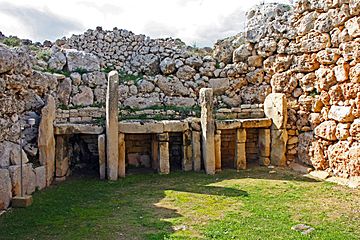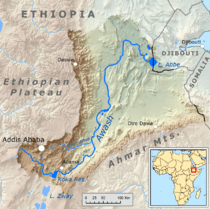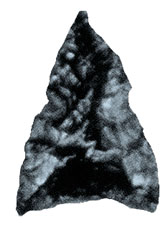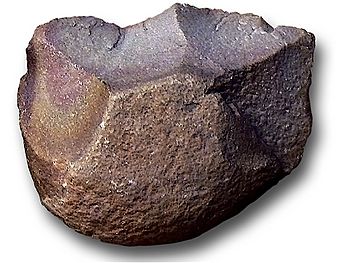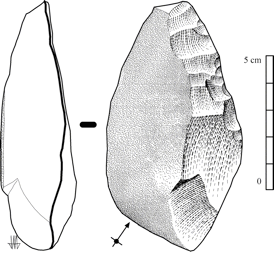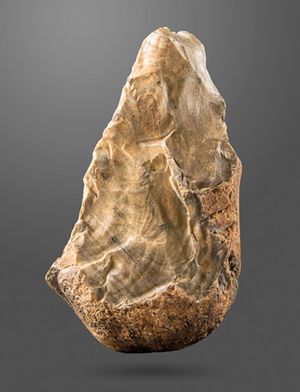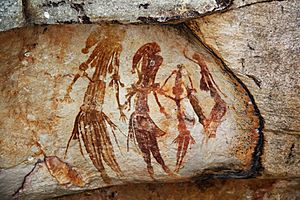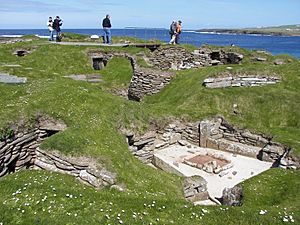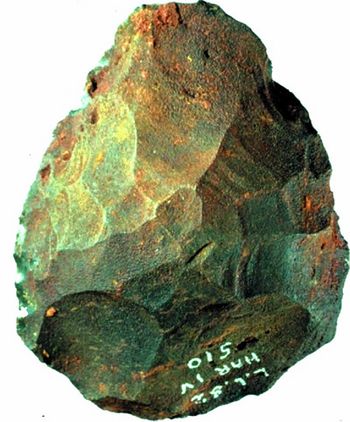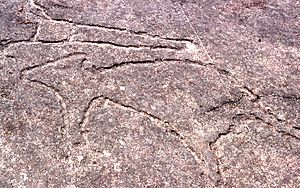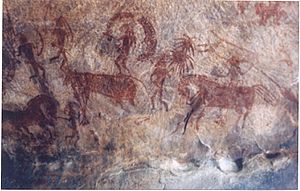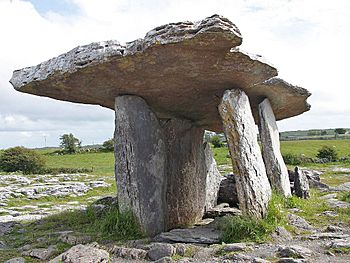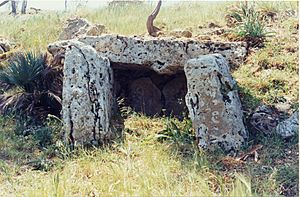Stone Age facts for kids
The Stone Age was a very long time in history when people mostly used stone to make their tools. This period lasted for about 3.4 million years! It ended between 4,000 BCE and 2,000 BCE when people learned how to work with metals. Even though some simple metal items like gold and copper jewelry were made during the Stone Age, the real end came when people learned to melt and smelt copper.
In places like Western Asia, the Stone Age finished around 3,000 BCE when bronze became common. The time after the Stone Age is called the Bronze Age. During this time, people used bronze tools instead of stone ones.
Archaeologists have found many Stone Age tools. These tools were used by early humans, their ancestors (like Homo), and possibly even older groups like Australopithecus and Paranthropus. Tools made from bone were also used, but they don't last as long in the ground. The Stone Age is divided into different parts based on the types of stone tools people used.
The Stone Age is the first part of a system archaeologists use to organize human history. This system has three main parts: the Stone Age, the Bronze Age, and the Iron Age. The Stone Age itself is usually split into three periods:
- The Paleolithic era: This was the earliest and most basic time.
- The Mesolithic era: A time of change with better tools.
- The Neolithic era: The final stage.
During the Neolithic era, people started to change from being hunter-gatherers to living in settled towns and villages. This happened because farming became widespread. The Neolithic era often overlaps with the Chalcolithic (or "Copper") era, which came just before the Bronze Age.
Why the Stone Age Matters
The Stone Age happened at the same time as the evolution of early humans, called Homo. Some very early Stone Age tools might even have been made by species older than Homo. Scientists believe that early humans first appeared in the East African Rift system, especially in Ethiopia. This area had lots of grasslands.
Around 4 million years ago, a huge grassland area stretched from South Africa all the way to China. This area is sometimes called "savannahstan." Early humans like Homo erectus (an ancestor of modern humans) found a way to live here by making and using tools. They became very good at living in the savanna because of their tools.
Stone Age Discoveries
How the Stone Age Began
The oldest signs of stone tool use are fossilized animal bones with tool marks on them. These are 3.4 million years old and were found in Ethiopia. In 2015, even older tools were found in Kenya, dating back 3.3 million years. These "Lomekwian" tools might have been used by Kenyanthropus platyops, an early human relative.
Before these discoveries, the oldest known stone tools were found in Ethiopia, dating to 2.6–2.55 million years ago. These tools were made in the Late Pliocene period. This was surprising because scientists used to think tools only appeared later, in the Pleistocene period. The people who found these tools noted that the early toolmakers were already very skilled.
We don't know exactly which early human species made these Pliocene tools. Fragments of Australopithecus garhi, Australopithecus aethiopicus, and Homo (possibly Homo habilis) have been found near these tools. In 2018, scientists found stone tools in China that are 2.12 million years old. These are the oldest tools found outside of Africa.
How the Stone Age Ended
The Stone Age ended when people learned how to smelt ore (rock containing metal). This led to the Bronze Age. The first important metal made was bronze, which is a mix of copper and tin or arsenic.
The time when people could smelt copper but not yet make bronze is called the Copper Age (or Chalcolithic). This period is usually seen as the start of the Bronze Age. After the Bronze Age came the Iron Age.
The change from the Stone Age happened at different times around the world. In North Africa and Eurasia, it was between 6000 and 2500 BCE. The earliest signs of metalworking are from Serbia, around 6th to 5th millennia BCE. For example, a copper axe from 5500 BCE was found there. Ötzi the Iceman, a mummy from about 3300 BCE, even had a copper axe and a flint knife!
In some places, like Sub-Saharan Africa, the Stone Age went straight into the Iron Age. There was no Bronze Age there. The Middle East and Southeast Asia moved past Stone Age technology around 6000 BCE. Europe and the rest of Asia followed by about 4000 BCE. In South America, early cultures like the proto-Inca used stone tools until around 2000 BCE, when gold, copper, and silver appeared. Even after the Stone Age ended in an area, people still used stone tools for some things, like millstones for grinding grain, which were used until recently in many parts of the world.
Understanding the Stone Age Idea
The terms "Stone Age," "Bronze Age," and "Iron Age" don't just mean that people only used those materials. They also help us understand how societies changed. For example, how people organized themselves, what they ate, how they adapted to climate, and when they started farming.
Studying stone tools is a big part of archaeology. Scientists measure and examine tools to figure out what they were used for and how they were made. They even try to make replica tools to understand the process.
Archaeologists also use many other methods. They study rock layers, identify animal bones, find plant pollen, and use scientific dating methods like carbon-14 dating. The main goal is always to understand the people and societies who lived during the Stone Age.
However, the idea of the Stone Age has its limits. The exact dates for this period can be different depending on the region. Some groups of people never developed metal-smelting technology. They continued to use stone tools until they met cultures that had more advanced technology. The term "Stone Age" was first used to describe cultures in Europe. It might not fit perfectly for all parts of the world, like some islands where people used stone tools until European colonization.
It's important not to call any living group of people "primitive" or "Stone Age." This suggests they are stuck in an earlier stage of human development, which is not fair or accurate.
Different Ways to Divide the Stone Age
In the 1920s, archaeologists in South Africa realized that the European "Three-Age System" (Stone, Bronze, Iron) didn't quite fit their discoveries. So, they created a new system for Africa, called the "Three-Stage System."
This system divides the Stone Age into the Earlier, Middle, and Later Stone Age. While these terms refer to similar tools and technologies as the Paleolithic and Neolithic, they have different timelines and meanings in Africa. For example, in Sub-Saharan Africa, ironworking developed directly after the Stone Age, and there wasn't a separate Bronze Age.
Archaeologists from around the world meet regularly at the Pan-African Congress on Prehistory to agree on these classifications.
The Challenge of Transitions
One big challenge in archaeology is understanding how one period smoothly changes into another. For example, how did the Paleolithic become the Neolithic? If there's no clear transition, it would mean people suddenly changed all their customs, which is unlikely. Instead, there should be a period where old ways gradually fade and new ones appear.
In Europe, it was hard to find these transitions. But then, Louis Leakey showed that humans evolved in Africa. This meant that different phases of the Stone Age might have appeared in Europe through migration, without needing a local transition. Now, African archaeologists are working hard to find these missing transitions in Africa. It's a difficult but ongoing puzzle!
Stone Age Timeline
In 1859, Jens Jacob Worsaae first suggested dividing the Stone Age into older and younger parts. This simple idea grew into the archaeological periods we use today. The main parts of the Stone Age cross two big geological time periods:
- The Pliocene–Pleistocene boundary (a very cold, icy climate).
- This includes the Paleolithic period in archaeology.
- The Pleistocene–Holocene boundary (our modern climate).
- This includes the Mesolithic or Epipaleolithic period.
- And the Neolithic period.
The order of these phases can be very different depending on the region or culture.
The Three-Age Timeline
The Paleolithic (meaning "Old Stone Age") is the earliest and longest part of the Stone Age. It covers about 99% of human technological history! It started around 2.5 or 2.6 million years ago, when early humans like Homo habilis first used stone tools. It ended around 10,000 BCE, with the end of the last ice age. The Paleolithic era was followed by the Mesolithic, or in some areas, the Epipaleolithic.
Lower Paleolithic Period
In the Lower Paleolithic Period (about 2,500,000 to 200,000 years ago), simple pebble tools were found with the remains of early human ancestors. A more advanced tool-making style, called the Chopper chopping-tool industry, was common in the Eastern Hemisphere. Scientists think Homo erectus made these tools. H. erectus probably also made tools from wood and bone, but these don't usually survive.
Around 700,000 years ago, a new tool called the hand axe appeared. The earliest hand axes in Europe are from the Abbevillian industry in France. Later, the more refined Acheulian industry made even better hand axes. These have been found in Europe, Africa, the Middle East, and Asia. Some of the oldest hand axes were found at Olduvai Gorge in Tanzania, with H. erectus remains.
Alongside hand axes, people also made tools from stone flakes. The Clactonian industry in Europe is an example of this. These early flake tools likely led to the Middle Paleolithic flake tools of the Mousterian industry, which are linked to Neanderthal man.
Oldowan Tools in Africa
The very first stone tools were found in eastern Africa, at a 3.3-million-year-old site in Kenya. Later, tools from an industry called Oldowan were found at Olduvai Gorge in Tanzania.
Oldowan tools were made by hitting a river pebble with another stone (a hammerstone). This created sharp edges. The original stone is called a core, and the pieces that broke off are called flakes. This method is often called "core-and-flake." More recently, it's been called "small flake" because the flakes were small compared to later tools.
These "pebble cores" could be used for cutting, scraping, or chopping. They were useful in places where naturally sharp rocks weren't available. Scientists have even found mammalian blood cells on some Oldowan tools in South Africa, suggesting they were used for butchering animals. Plant remains on other tools show they were also used to chop plants.
While we don't know the exact species that first made these tools, Homo habilis mostly used Oldowan tools in Africa. They likely continued a tool-making tradition that was already very old. Chimpanzees sometimes use stones to prepare food, so this type of tool use might be much older than we know.
Towards the end of the Oldowan period in Africa, a new species appeared: Homo erectus. This happened around 1.8–1.7 million years ago, possibly because the climate became drier, forcing early humans to travel further for food. H. erectus was able to travel long distances and carried Mode 1 tools (Oldowan) across Eurasia.
Oldowan tools are found in Africa from about 2.6 million years ago to 1.5 million years ago. Outside Africa, they lasted until about 0.5 million years ago. Homo habilis lived from 2.3 to 1.4 million years ago, and H. erectus from 1.8 to 0.6 million years ago. This means several early human species used Mode 1 tools at the same time.
Oldowan Tools Outside Africa
Oldowan tools were first noticed by archaeologists in Europe. They were a bit confusing because they weren't as well-defined as later tools. But discoveries in Africa helped explain them. The term "Pre-Acheulean" was sometimes used for these older tools in Europe and Asia.
There's strong evidence of H. erectus using Mode 2 tools in Eurasia. But there are also some Mode 1 tools linked to H. erectus, especially in the Far East. At Yiron, Israel, Mode 1 tools were found dating to 2.4 million years ago. This is about 0.5 million years earlier than the oldest known H. erectus finds. This suggests that either another early human species left Africa before H. erectus, or we just haven't found the earliest H. erectus yet.
Pebble tools are found in South Africa (2.0 mya), Algeria (1.8 mya), Israel (2.4 mya), Pakistan (2.0 mya), and South China (over 2 mya). A skull found in Java, dated to 1.8 mya, is identified as H. erectus. This makes scientists wonder if H. erectus might have originated in Asia, not Africa. H. erectus was also found in Georgia, from 1.75 mya, with pebble tools.
In Europe, pebble tools appeared later, first in southern Europe (Italy and Spain) around 1.6 mya. They reached northern Europe, like the United Kingdom, around 0.8 mya. The last traces are from Kent's Cavern, dated 0.5 mya. By then, H. erectus was thought to be extinct, but a more modern version, Homo heidelbergensis, likely inherited these tools.
In the past, archaeologists thought one human species and culture replaced another. Now, we know that different early human species lived at the same time in the same areas for long periods. Also, by the time the "earliest" cultures reached northern Europe, other parts of Africa and Eurasia had already moved on to later Stone Age periods.
Acheulean Tools in Africa
The Oldowan period in Africa ended with the appearance of Acheulean (or Mode 2) stone tools. The earliest Acheulean tools are found in Kenya, dating to 1.7–1.6 million years ago. They are often found with H. erectus, leading scientists to believe that H. erectus invented these more advanced tools.
A Mode 2 tool is a "biface," meaning it's shaped on both sides to create a sharp cutting edge all around. Making these tools required more work and planning. The toolmaker would strike a large piece off a rock, then shape it by hitting off smaller flakes with a hammerstone. Finally, they would sharpen the edge by hitting off tiny flakes with a bone or wood hammer.
Acheulean tools are usually much larger than Oldowan tools. They are often called "Large Cutting Tools" (LCTs).
In North Africa, the oldest Mode 2 finds are from Morocco, around 0.9 million years ago. Archaeological focus also shifts to the Jordan Rift Valley, which is connected to the East African Rift Valley. Early humans could have easily reached the ancient Jordan River from Ethiopia along the Red Sea coast.
Acheulean tools continued to be used in Africa even after H. erectus died out there. The last Acheulean tools in East Africa are from Kenya, dated to about 0.9 million years ago. In South Africa, Acheulean tools from 1.0–0.6 million years ago are linked to Homo heidelbergensis, a more advanced descendant of H. erectus.
Acheulean Tools Outside Africa
Mode 2 tools first appeared outside Africa at 'Ubeidiya, Israel. This site was once a lake shore where early humans lived for hundreds of thousands of years. The tools found there are from about 1.6–1.2 million years ago.
At 'Ubeidiya, marks on animal bones show that the toolmakers butchered animals killed by large predators. They were "scavenging" for meat, especially from deer. Most of the animals were from Europe and Asia, but 30–60% were from Africa, showing an overlap of animal ranges. H. erectus skull fragments were found there. The tools are called "Lower Acheulean" and "Developed Oldowan." This timeline, later than in Kenya, supports the idea that Acheulean tools spread "out of Africa."
From Southwest Asia, Acheulean tools slowly spread eastward, reaching India around 1.2 million years ago. They didn't appear in China and Korea until after 1 million years ago, and not at all in Indonesia. There's a clear boundary called the Movius Line that shows how far Acheulean tools spread eastward before 1 million years ago. East of this line, people continued to use Mode 1 tools, but they were more carefully shaped. However, after 1 million years ago, Acheulean tools did appear in places like Bose, China (0.803 million years ago). We don't know if this later Acheulean technology developed locally or was brought in.
In Europe, Mode 2 tools also appeared late. The earliest are from Spain, dating to over 0.9 million years ago. The last Mode 2 tools in Southern Europe are from Italy, dated to 0.45 million years ago, linked to Homo cepranensis, a late version of H. erectus.
Middle Paleolithic Period
This period is famous for the Neanderthals, who lived in Europe and the Near East (about 300,000–28,000 years ago). They mainly used Mousterian tools. Neanderthals cared for their elderly and buried their dead, which shows they had an organized society. There's no evidence of Neanderthals in Africa, Australia, or the Americas.
The earliest signs of humans settling in Australia date back about 40,000 years ago. Modern humans likely traveled there from Asia by "island-hopping." During this time, there's some debate about whether early humans showed symbolic behavior, like body decoration or special burials. The Bhimbetka rock shelters in India show early signs of human life from about 30,000 years ago.
Upper Paleolithic Period
The Upper Paleolithic in Europe lasted from 50,000 to 10,000 years ago, ending with the last ice age. During this time, modern humans spread out across the Earth.
The Upper Paleolithic saw quick changes in stone tool technology. There was also a big increase in art and personal decorations. Different tool-making styles developed, like Châtelperronian, Aurignacian, Gravettian, Solutrean, and Magdalenian. Most of these are linked to anatomically modern humans.
Most experts believe humans arrived in Australia 40,000 to 50,000 years ago. The oldest modern human remains found in Australia (and outside Africa) are the Mungo Man, dated at 42,000 years old.
The Americas were settled by people crossing the Bering land bridge, which was exposed when sea levels were lower. These people are called the Paleo-Indians. The earliest accepted sites, like those of the Clovis culture, are about 13,500 years ago. Around the world, societies were still hunter-gatherers, but different types of stone tools appeared, showing that people were adapting to different environments.
Epipaleolithic/Mesolithic Period
This period started at the end of the last ice age, about 10,000 years ago, and lasted until around 6,000 years ago. During this time, sea levels rose, and people had to adapt to a changing environment and find new food sources. They started making Mode 5 tools, called microliths. These were small, sharp stone tools used in more efficient composite tools (tools made of several parts). This led to more intense hunting and fishing.
With more social activity, more complex settlements developed, like Lepenski Vir. It's also likely that dogs were first domesticated as hunting companions during this time. The earliest known battle happened during the Mesolithic period at a site in Egypt called Cemetery 117.
Neolithic Period
The Neolithic, or New Stone Age, was mostly known for the adoption of agriculture. This shift from gathering food to producing it was a huge change in human history. It also brought the Neolithic Revolution: people started making pottery, using polished stone tools, and building larger, more complex settlements like Göbekli Tepe and Çatal Hüyük. Some of these changes began even earlier, in the Mesolithic.
The first Neolithic cultures started around 7000 BCE in the fertile crescent (Middle East) and spread from there. However, farming also developed independently in other places, like maize in Meso-America and rice in the Far East.
Because people needed to harvest and process plants, ground stone and polished stone tools became very common. These included tools for grinding, cutting, and chopping. Skara Brae in Scotland is a great example of a Neolithic village. It has stone beds, shelves, and even an indoor toilet! The first large buildings, like settlement towers and walls (e.g., Jericho) and ceremonial sites (e.g., Stonehenge), were built. The Ġgantija temples in Malta are the oldest free-standing structures in the world, built around 3600–2500 BCE.
During the Neolithic, there's also evidence of established trade. People living in new settlements imported interesting goods from hundreds of miles away. This shows that there were enough resources and cooperation for large groups to work on big projects. Most Neolithic societies were fairly simple and equal, though some later ones formed more complex groups led by chiefs.
African Stone Age Timeline
Early Stone Age (ESA)
The Early Stone Age in Africa is different from the European "Old Stone Age" (Paleolithic). It includes the same main technologies, Oldowan and Acheulean, which made Mode 1 and Mode 2 stone tools. But it has its own specific locations and timelines.
Middle Stone Age (MSA)
The Middle Stone Age in Africa was between the Early Stone Age and the Late Stone Age. It started around 300,000 years ago and ended about 50,000 years ago. It's similar to the European Middle Paleolithic. This period is linked to anatomically modern or nearly modern Homo sapiens. Early human remains from this time have been found in Ethiopia, dating back to about 195,000 and 160,000 years ago.
Later Stone Age (LSA)
The Later Stone Age (LSA) in Africa began around the same time as the European Upper Paleolithic. It continued until historical times. This period includes cultures that are similar to the Mesolithic and Neolithic in other parts of the world.
Stone Age Culture
Tools and Materials
Stone tools were made from various types of stone. For example, flint and chert were chipped to make sharp cutting tools and weapons. Basalt and sandstone were used for ground tools, like grinding stones. People also used wood, bone, shells, antlers (from deer), and other natural materials. In the later part of the Stone Age, people started using clay to make pottery. They also developed agriculture and domesticated certain animals.
Some animals, like sea otters, can use stone tools. But only humans (and early human relatives) depend on tools for survival. Humans have special hands with larger thumbs and different grips that allow them to make and use complex tools.
Food and Drink
Stone Age hunter-gatherers ate wild plants and animals from their environment. They liked eating animal organs, such as livers, kidneys, and brains. Large beans were part of the human diet long before the agricultural revolution. Recent findings show that humans processed and ate wild cereal grains as far back as 23,000 years ago.
Near the end of the Wisconsin glaciation (15,000 to 9,000 years ago), many large animals like mammoths died out in Asia, Europe, North America, and Australia. This was the first big extinction event of our current geological period. This might have forced humans to change their diets. With the start of farming, plant-based foods became a regular part of their meals. Many things might have caused this extinction, including over-hunting, cutting down forests, and climate change.
Shelter and Homes
Around 2 million years ago, Homo habilis might have built the first human-made structure in East Africa. It was a simple arrangement of stones to hold tree branches. A similar stone circle, about 380,000 years old, was found in France at Terra Amata. Many Stone Age homes have been found around the world:
- A tent-like structure inside a cave in France.
- A structure with a timber roof, found in the Czech Republic, dating to about 23,000 BCE. Its walls were made of clay blocks and stones.
- Many huts made of mammoth bones have been found in Eastern Europe and Siberia. The people who built these were skilled mammoth hunters.
- An animal hide tent from about 15,000 to 10,000 BCE was found in France.
Art and Creativity
Prehistoric art can be seen in many artifacts. We can guess about Prehistoric music from instruments that have been found. Parietal art (art on rocks) includes petroglyphs and rock paintings. We don't always know if this art had a religious purpose.
Petroglyphs
Petroglyphs appeared in the Neolithic period. A petroglyph is an abstract or symbolic image carved into natural stone. These were a main type of early symbols before writing. Petroglyphs have been found all over the world, including Australia, Asia (like Bhimbetka in India), North America, South America, and Europe.
Rock Paintings
In Paleolithic times, people mostly painted animals. These were probably animals they hunted or animals that represented strength, like rhinos or large cats (as seen in the Chauvet Cave). Sometimes, simple signs like dots were drawn. Human figures were rare, but handprints and half-human/half-animal figures have been found.
The Chauvet Cave in France has some of the most important Paleolithic cave paintings, dating from about 36,000 BCE. The Altamira cave paintings in Spain (14,000 to 12,000 BCE) show bisons and other animals. The hall of bulls in Lascaux, France, dates from about 15,000 to 10,000 BCE.
The meaning of many of these paintings is still a mystery. They might have been used for seasonal rituals or magic. Some symbols in Lascaux are thought to be calendars, but this is just a guess.
However, some Mesolithic paintings are clearer. For example, a rock painting in Spain from about 7,000–4,000 BCE shows two groups of about 50 archers marching towards each other, each carrying a bow and arrows. In other paintings, men wear special head-dresses but fight without clothes. Some scenes show dead and wounded people with arrows in them. This reminds us of Ötzi the Iceman, a Copper Age mummy found with an arrow wound.
Stone Age Beliefs and Rituals
Studies of Stone Age finds show that people in prehistoric times had certain rituals and beliefs. Their activities went beyond just finding food and shelter. They practiced specific rites related to death and burial, though these varied between cultures.
- Megalithic tombs, which are tombs with many chambers, and dolmens, which have a single chamber, have been found all over Europe and Asia. These were built in the Neolithic and Bronze Age. They are graves with huge stone slabs placed over other large stone slabs.
The Stone Age in Pop Culture
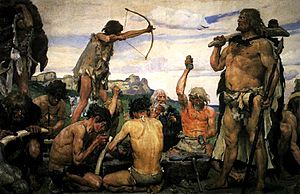
The idea of the caveman is often linked to the Stone Age. For example, a TV show about human evolution was called Walking with Cavemen, even though only the last part showed humans living in caves.
Sometimes, cartoons and movies like The Flintstones or One Million Years B.C. show humans and dinosaurs living together. But this is not supported by any scientific evidence. Dinosaurs died out millions of years before humans appeared!
Other stories about the Stone Age include the Earth's Children book series by Jean M. Auel. These books are set in the Paleolithic and are based on archaeological findings. The 1981 film Quest for Fire tells the story of early humans searching for fire. The Chronicles of Ancient Darkness book series by Michelle Paver is about two New Stone Age children trying to fulfill a prophecy.
See also
 In Spanish: Edad de Piedra para niños
In Spanish: Edad de Piedra para niños


